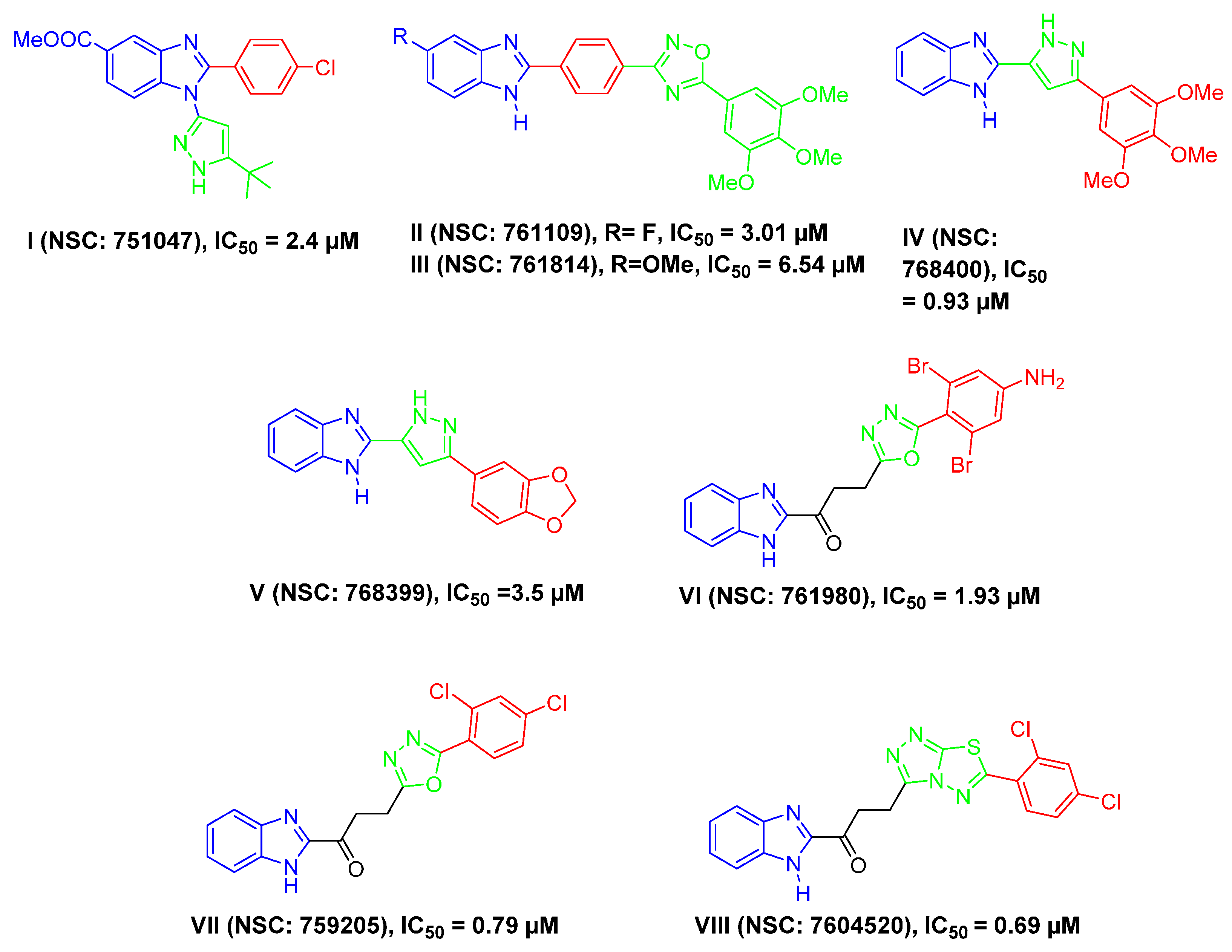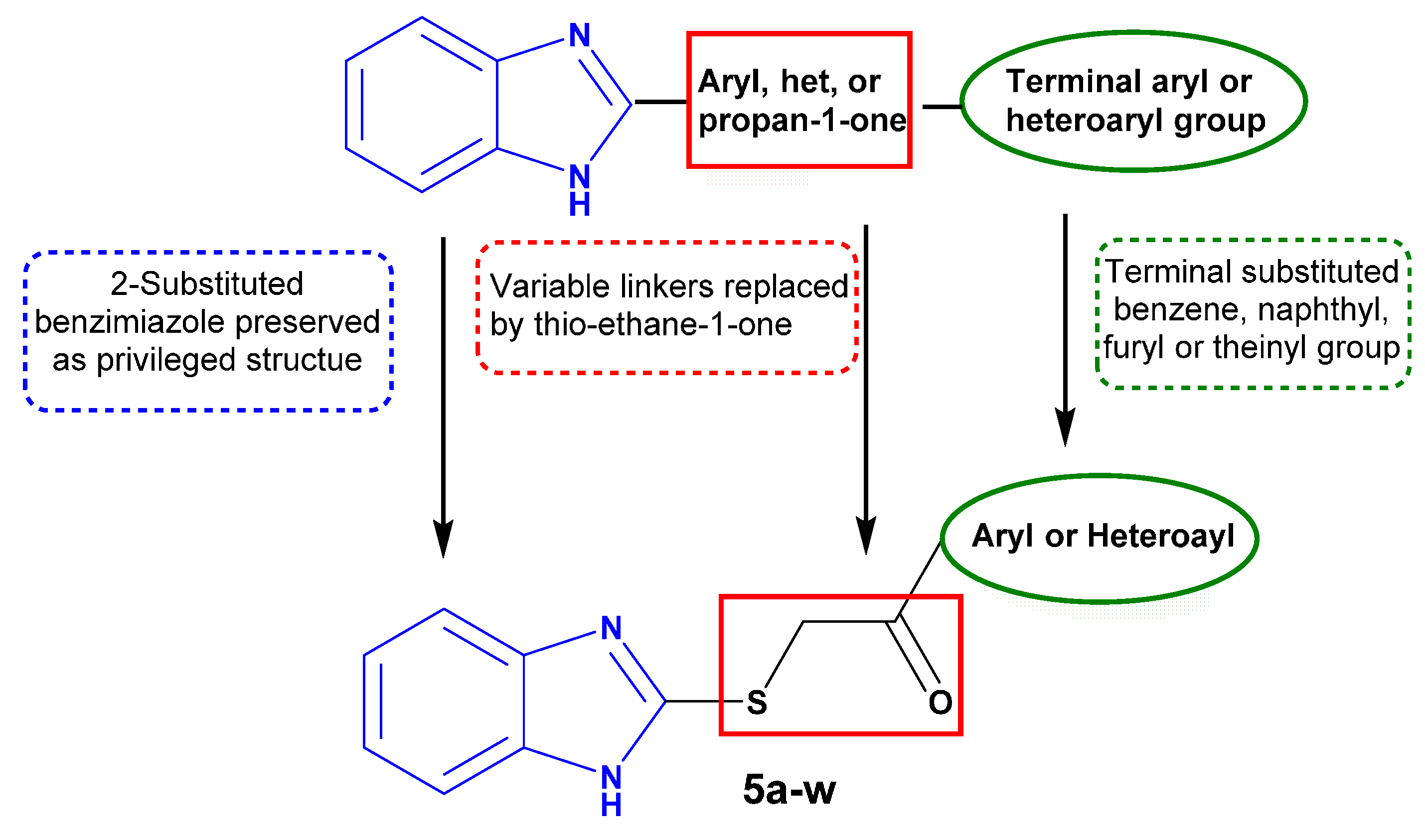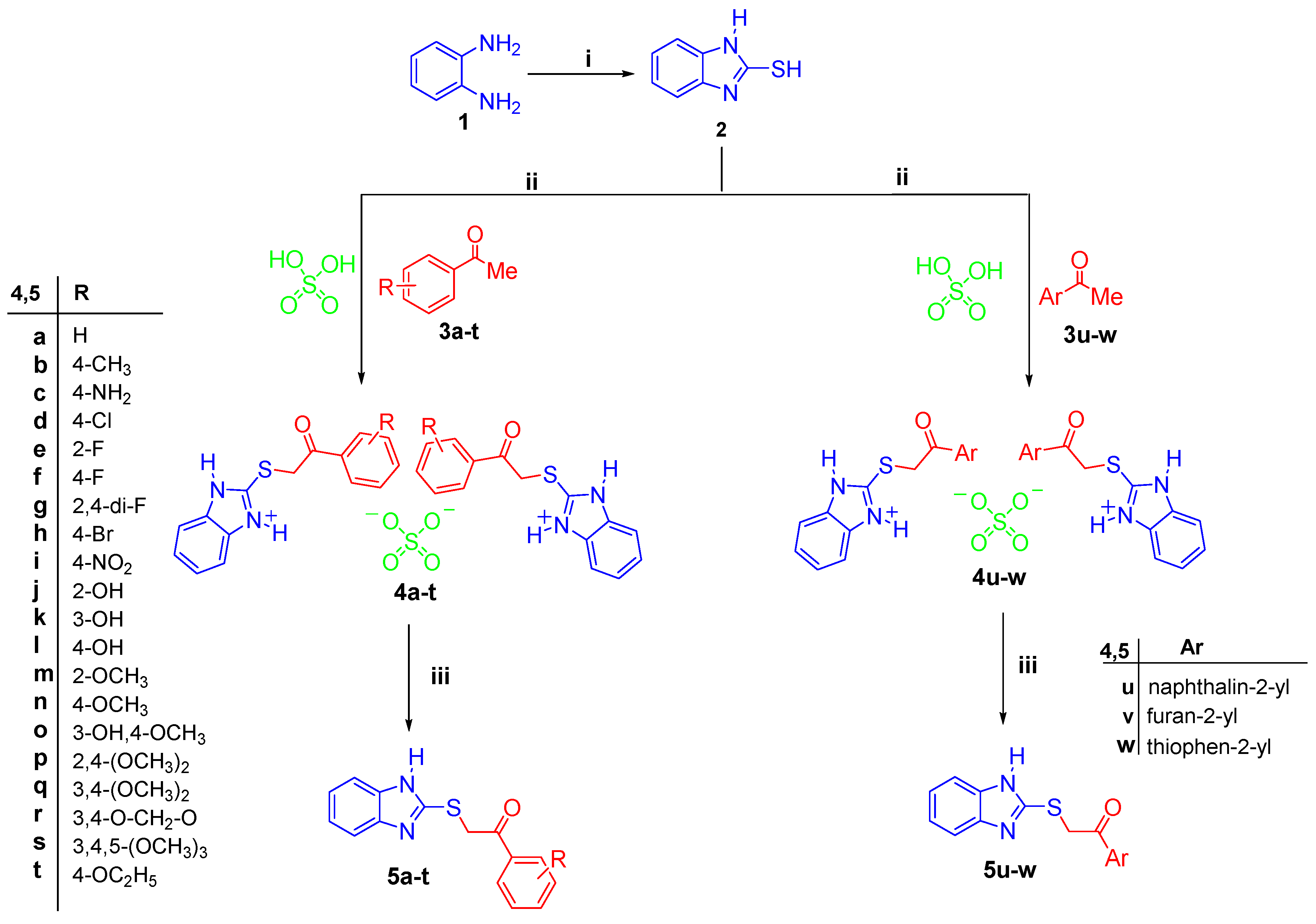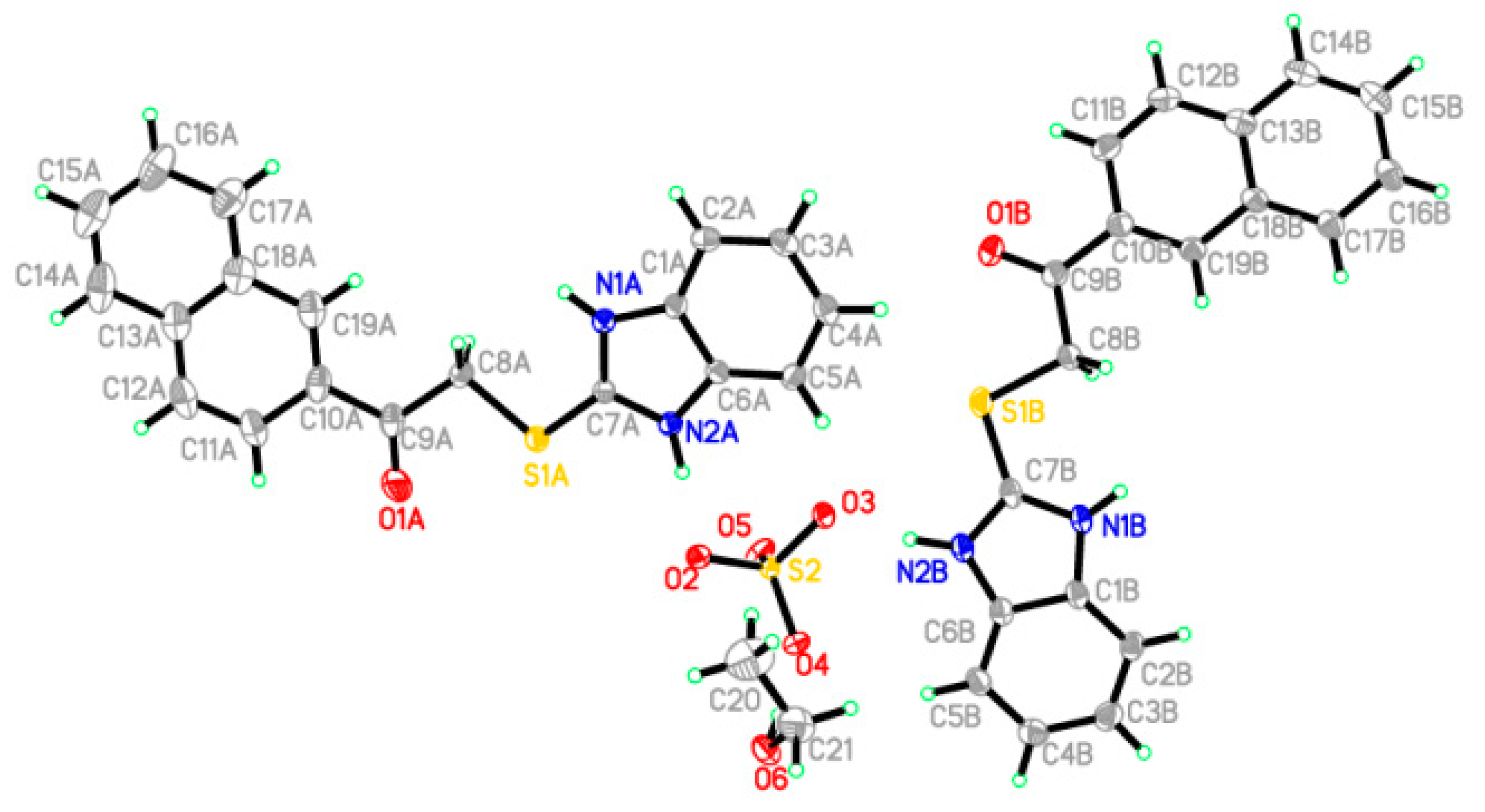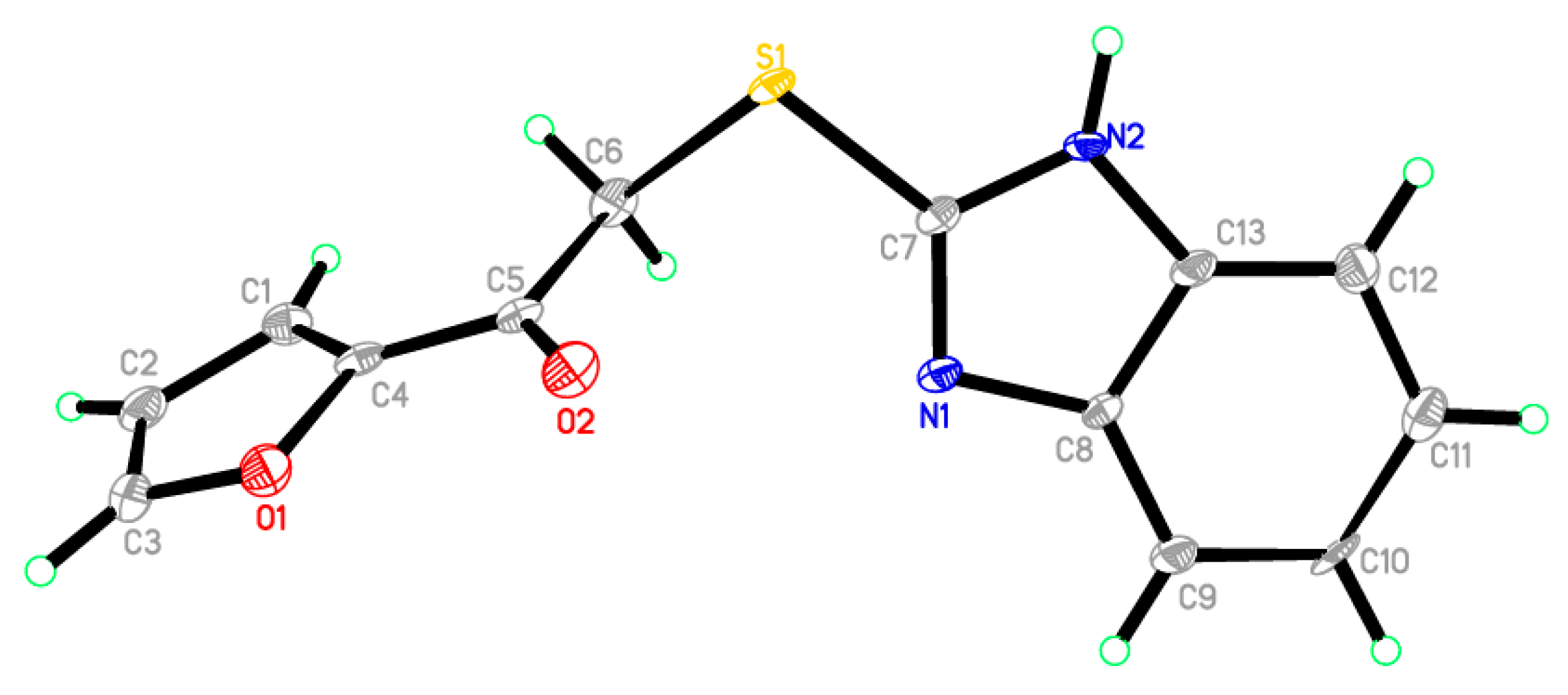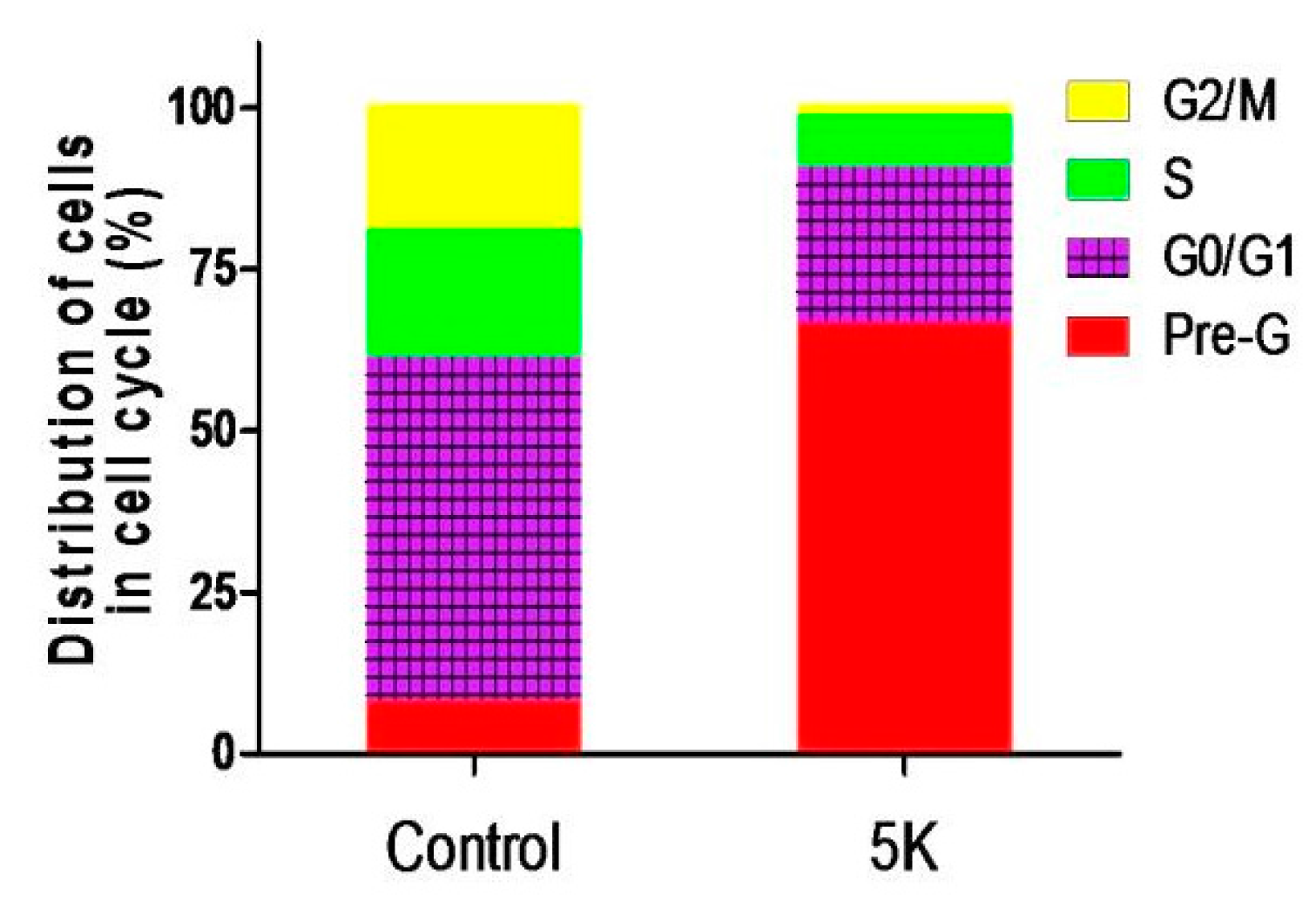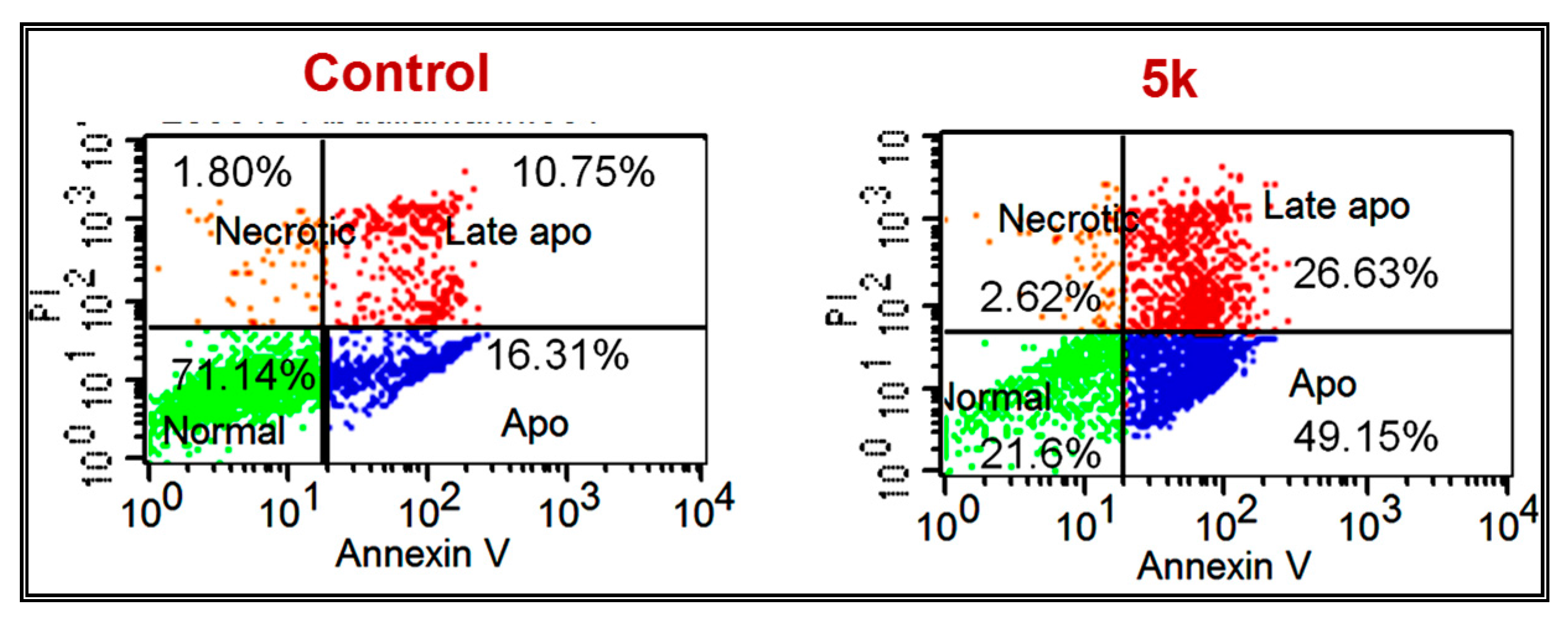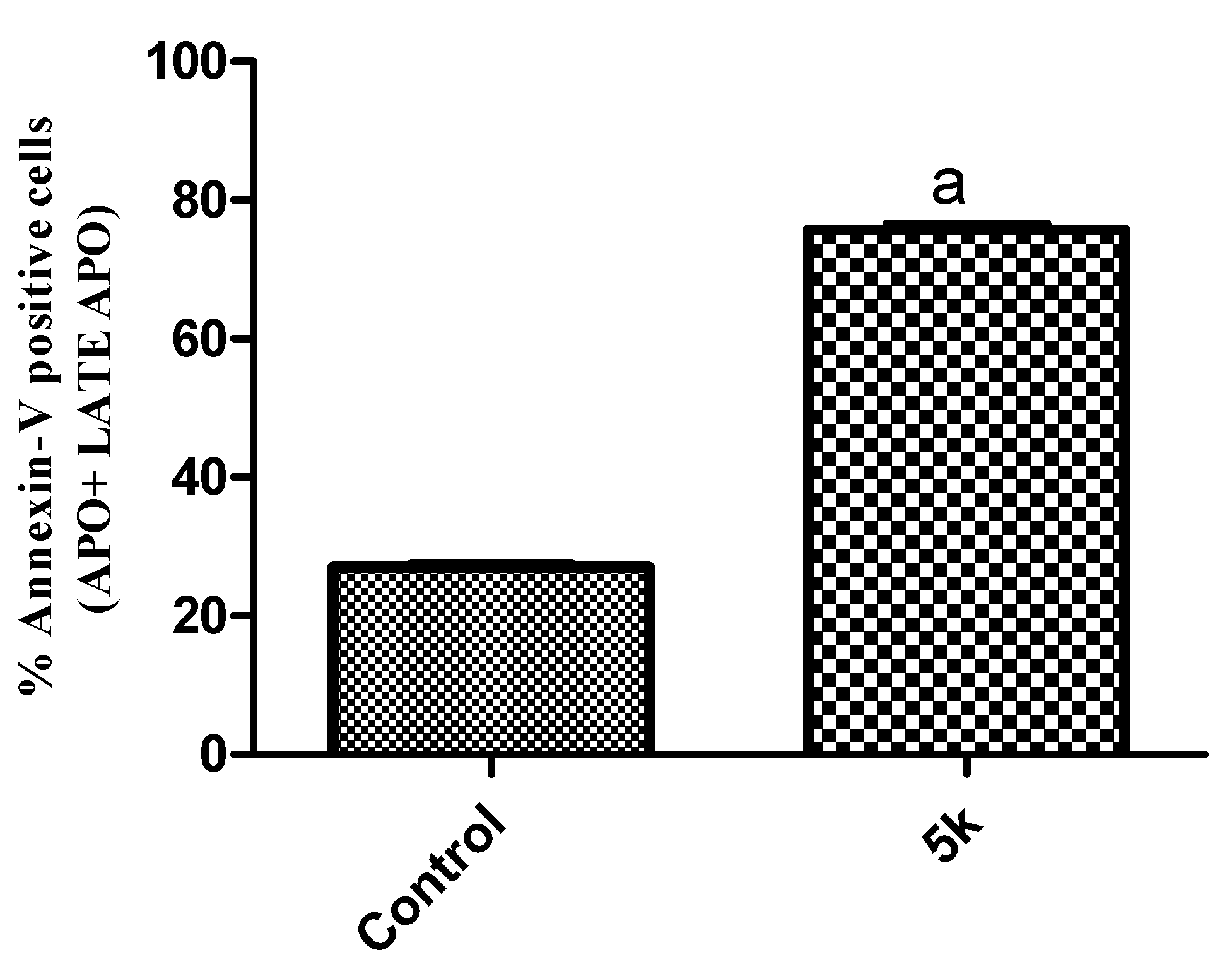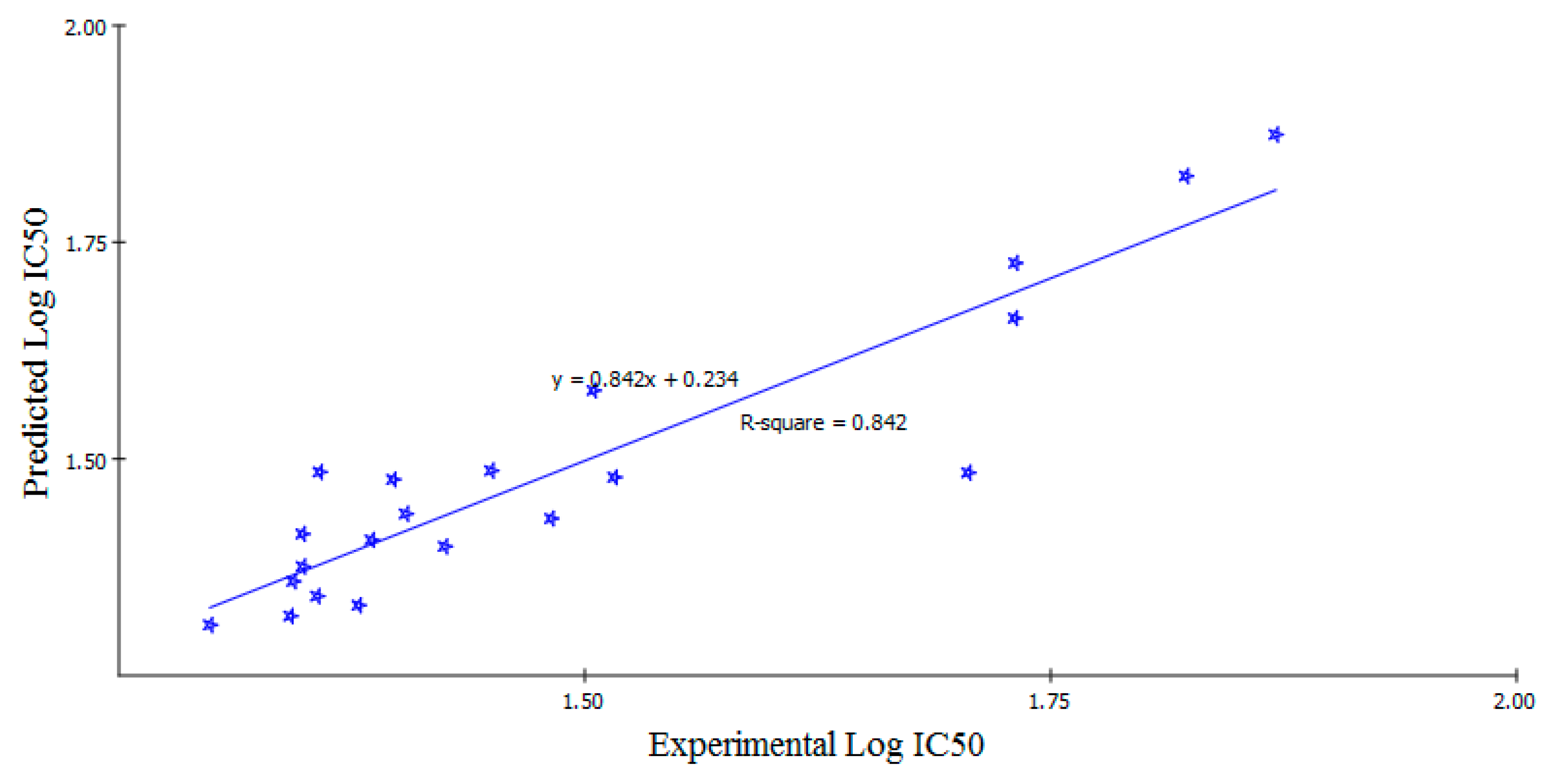4.1.3. General Procedures for Synthesis of Sulfate Salts 4a–w
Prepared according to the reported procedures [
28].
2-((2-(4-Aminophenyl)-2-oxoethyl)thio)-1H-benzo[d]imidazol-3-ium sulfate (4c). White crystals, (yield 97%), m.p. 210–213 °C; IR (KBr, ν cm−1): 3450 (NH) and 1684 (C=O); 1H-NMR (DMSO-d6) δ ppm: 5.23 (s, 2H, CH2), 6.65 (d, 2H, H-3 and H-5 of 4-NH2C6H4, J = 8.5 Hz), 6.70 (s, 2H, NH2), 7.49–7.51 (m, 2H, H-5 and H-6 of 2-mercaptobenzimidazole), 7.71–7.73 (m, 2H, H-4 and H-7 of 2-mercaptobenzimidazole), 7.87 (d, 2H, H-2 and H-6 of 4-NH2C6H4, J = 8.5 Hz), 10.55 (s, 1H, NH), 12.64 (s, 1H, NH); 13C-NMR (DMSO-d6) δ ppm: 41.55 (CH2), 113.40, 113.59, 114.66, 125.76, 130.92, 131.62, 132.74, 151.68, 189.11, 195.74 (C=O); ESI MS m/z: 665 [M + 1]+; Anal. Calcd. for C30H28N6O6S3: C, 54.20; H, 4.25; N, 12.64; Found C, 54.28; H, 4.21; N, 12.75.
2-((2-(4-Chlorophenyl)-2-oxoethyl)thio)-1H-benzo[d]imidazol-3-ium sulfate (4d). White crystals, (yield 98%), m.p. 227–230 °C; IR (KBr, ν cm−1): 3400 (NH) and 1683 (C=O); 1H-NMR (DMSO-d6) δ ppm: 5.29 (s, 2H, CH2), 7.37–7.40 (m, 2H, H-5 and H-6 of 2-mercaptobenzimidazole), 7.62–7.65 (m, 2H, H-4 and H-7 of 2-mercaptobenzimidazole), 7.68 (d, 2H, H-3 and H-5 of 4-ClC6H4, J = 8.5 Hz), 8.08 (d, 2H, H-2 and H-6 of 4-ClC6H4, J = 8.5 Hz), 10.55 (s, 1H, NH), 12.61 (s, 1H, NH); 13C-NMR (DMSO-d6) δ ppm: 56.50 (CH2), 113.84, 120.85, 122.77, 124.68, 129.53, 130.89, 134.12, 134.86, 139.48, 150.64, 192.07 (C=O); ESI MS m/z: 703 [M + 1]+, 704 [M + 2]+; Anal. Calcd. for C30H24Cl2N4O6S3: C, 15.21; H, 3.44; N, 7.96; Found C, 15.30; H, 3.49; N, 8.02.
2-((2-(2-Fluorophenyl)-2-oxoethyl)thio)-1H-benzo[d]imidazol-3-ium sulfate (4e). White crystals, (yield 97%), m.p. 219–222 °C; IR (KBr, ν cm−1): 3435 (NH) and 1669 (C=O); 1H-NMR (DMSO-d6) δ ppm: 5.15 (s, 2H, CH2), 7.37–7.40 (m, 2H, H-5 and H-6 of 2-mercaptobenzimidazole), 7.41–7.48 (m, 2H, Ar–H), 7.60–7.62 (m, 2H, H-4 and H-7 of 2-mercaptobenzimidazole), 7.75–7.79 (m, 1H, Ar–H), 7.94 (t, 1H, H-6 of 2-FC6H4, J = 7.5 Hz), 10.64 (s, 1H, NH), 12.73 (s, 1H, NH). ESI MS m/z: 671 [M + 1]+; Anal. Calcd. for C30H24F2N4O6S3: C, 53.72; H, 3.61; N, 8.35; Found C, 53.67; H, 3.65; N, 8.38.
2-((2-(2,4-Difluorophenyl)-2-oxoethyl)thio)-1H-benzo[d]imidazol-3-ium sulfate (4g). White crystals, (yield 96%), m.p. 206–209 °C; IR (KBr, ν cm−1): 3468 (NH) and 1680 (C=O); 1H-NMR (DMSO-d6) δ ppm: 5.27 (s, 2H, CH2), 7.30 (t, 1H, Ar–H, J = 8.5 Hz), 7.43–7.46 (m, 2H, H-5 and H-6 of 2-mercaptobenzimidazole), 7.52 (t, 1H, Ar–H, J = 9.0 Hz), 7.65–7.69 (m, 2H, H-4 and H-7 of 2-mercaptobenzimidazole), 8.03 (t, 1H, Ar–H, J = 9.0 Hz),10.52 (s, 1H, NH), 12.67 (s, 1H, NH); 13C-NMR (DMSO-d6) δ ppm: 44.06 (CH2), 105.70, 105.91, 106.12, 113.09, 113.27, 113.76, 120.81, 125.25, 133.50, 133.85, 150.71, 189.03 (C=O). ESI MS m/z: 707 [M + 1]+; Anal. Calcd. for C30H22F4N4O6S3: C, 50.99; H, 3.14; N, 7.93; Found C, 50.91; H, 3.18; N, 8.01.
2-((2-(2-Hydroxyphenyl)-2-oxoethyl)thio)-1H-benzo[d]imidazol-3-ium sulfate (4j). White crystals, (yield 98%), m.p. 238–240 °C; IR (KBr, ν cm−1): 3466 (NH) and 1684 (C=O); 1H-NMR (DMSO-d6) δ ppm: 5.30 (s, 2H, CH2), 7.02–7.11 (m, 4H, Ar–H), 7.38–7.42 (m, 2H, H-5 and H-6 of 2-mercaptobenzimidazole), 7.67–7.70 (m, 2H, H-4 and H-7 of 2-mercaptobenzimidazole), 9.59 (s, 1H, OH), 10.60 (s, 1H, NH), 12.87 (s, 1H, NH). ESI MS m/z: 667 [M + 1]+, 668 [M + 2]+; Anal. Calcd. for C30H26N4O8S3: C, 54.04; H, 3.93; N, 8.40; Found C, 54.12; H, 3.91; N, 8.46.
2-((2-(3-Hydroxyphenyl)-2-oxoethyl)thio)-1H-benzo[d]imidazol-3-ium sulfate (4k). White crystals, (yield 97%), m.p. 228–230 °C; IR (KBr, ν cm−1): 3418 (NH) and 1670 (C=O); 1H-NMR (DMSO-d6) δ ppm: 5.34 (s, 2H, CH2), 7.11 (d, 1H, H-4 of 3-OHC6H4, J = 8.0 Hz), 7.40–7.44 (m, 2H, H-2 and H-3 of 3-OHC6H4), 7.47–7.49 (m, 2H, H-5 and H-6 of 2-mercaptobenzimidazole), 7.54 (d, 1H, H-6 of 3-OHC6H4, J = 8.0 Hz), 7.70–7.72 (m, 2H, H-4 and H-7 of 2-mercaptobenzimidazole), 9.73 (s, 1H, OH), 10.48 (s, 1H, NH), 12.61 (s, 1H, NH); 13C-NMR (DMSO-d6) δ ppm: 41.58 (CH2), 113.69, 115.09, 120.03, 121.82, 125.59, 130.55, 133.19, 136.46, 151.08, 158.23, 192.52 (C=O). ESI MS m/z: 667 [M + 1]+; Anal. Calcd. for C30H26N4O8S3: C, 54.04; H, 3.93; N, 8.40; Found C, 54.13; H, 4.03; N, 8.46.
2-((2-(2,4-Dimethoxyphenyl)-2-oxoethyl)thio)-1H-benzo[d]imidazol-3-ium sulfate (4p). White crystals, (yield 98%), m.p. 235–237 °C; IR (KBr, ν cm−1): 3377 (NH) and 1680 (C=O); 1H-NMR (DMSO-d6) δ ppm: 3.88 (s, 3H, OCH3), 4.00 (s, 3H, OCH3), 5.08 (s, 2H, CH2), 6.67 (d, 1H, H-5 of 2,4-(OCH3)2C6H3, J = 9.0 Hz), 6.74 (s, 1H, H-3 of 2,4-(OCH3)2C6H3), 7.43–7.44 (m, 2H, H-5 and H-6 of 2-mercaptobenzimidazole), 7.65–7.66 (m, 2H, H-4 and H-7 of 2-mercaptobenzimidazole), 7.79 (d, 1H, H-6 of 2,4-(OCH3)2C6H3, J = 9.0 Hz), 10.46 (s, 1H, NH), 12.37 (s, 1H, NH); 13C-NMR (DMSO-d6) δ ppm: 45.31 (CH2), 56.33 (OCH3), 56.73 (OCH3), 98.92, 107.24, 113.37, 117.65, 121.38, 125.12, 133.06, 151.57, 162.02, 165.95, 191.78 (C=O). ESI MS m/z: 755 [M + 1]+; Anal. Calcd. for C34H34N4O10S3: C, 54.10; H, 4.54; N, 7.42; Found C, 54.16; H, 4.59; N, 7.38.
2-((2-(3,4,5-Trimethoxyphenyl)-2-oxoethyl)thio)-1H-benzo[d]imidazol-3-ium sulfate (4s). White crystals, (yield 98%), m.p. 213–215 °C; IR (KBr, ν cm−1): 3427 (NH) and 1675 (C=O); 1H-NMR (DMSO-d6) δ ppm: 3.77 (s, 6H, 2OCH3), 3.89 (s, 12H, 4OCH3), 5.29 (s, 4H, 2CH2), 7.40–7.67 (m, 12H, Ar–H), 10.67 (s, 2H, 2NH), 12.49 (s, 2H, 2NH). ESI MS m/z: 815 [M + 1]+, 816 [M + 2]+; Anal. Calcd. for C36H38N4O12S3: C, 53.06; H, 4.70; N, 6.88; Found C, 52.96; H, 4.63; N, 6.80.
2-((2-(Naphthalen-2-yl)-2-oxoethyl)thio)-1H-benzo[d]imidazol-3-ium sulfate (4u). White crystals, (yield 96%), m.p. 246–250 °C; IR (KBr, ν cm−1): 3412 (NH) and 1670 (C=O); 1H-NMR (DMSO-d6) δ ppm: 5.38 (s, 2H, CH2), 7.31–7.33 (m, 2H, H-5 and H-6 of 2-mercaptobenzimidazole), 7.57–7.60 (m, 2H, H-4 and H-7 of 2-mercaptobenzimidazole), 7.66–7.74 (m, 2H, H-6 and H-7 of naphthalene), 8.04 (d, 2H, Ar–H, J = 8.5 Hz), 8.08 (d, 1H, Ar–H, J = 8.5 Hz), 8.17 (d, 1H, Ar–H, J = 8.0 Hz), 8.85 (s, 1H, H-1 of naphthalene), 10.54 (s, 1H, NH), 12.68 (s, 1H, NH); 13C-NMR (DMSO-d6) δ ppm: 56.49 (CH2), 113.96, 123.93, 124.13, 127.72, 128.26, 129.01, 130.14, 131.27, 132.56, 132.83, 135.79, 136.26, 150.58, 193.14 (C=O). ESI MS m/z: 735 [M + 1]+; Anal. Calcd. for C38H30N4O6S3: C, 62.11; H, 4.11; N, 7.62; Found C, 62.18; H, 4.13; N, 7.57.
4.1.4. General Procedure for Preparation of the Target Derivatives 5a–w
An aqueous solution (10 mL) of sodium bicarbonate was added to a stirred suspension of the adequate sulfate salts 4a–w (4 mmol) in water (20 mL). The mixture was stirred for 2 h at room temperature. The obtained solid was collected by filtration, washed several times with water, then dried and recrystallized from ethanol to furnish compounds 5a–w.
2-((1H-Benzo[d]imidazol-2-yl)thio)-1-(4-aminophenyl)ethan-1-one (5c). White crystals (yield 85%), m.p. 175–178 °C; IR (KBr, ν cm−1): 3412 (NH) and 1680 (C=O); 1H-NMR (DMSO-d6) δ ppm: 4.87 (s, 2H, CH2), 6.21 (s, 2H, NH2), 6.59 (d, 2H, H-3 and H-5 of 4-NH2C6H4, J = 9.0 Hz), 7.10–7.14 (m, 4H, H-4, H-5, H-6 and H-7 of 2-mercaptobenzimidazole), 7.76 (d, 2H, H-2 and H-6 of 4-NH2C6H4, J = 8.5 Hz), 12.53 (s, 1H, NH); 13C-NMR (DMSO-d6) δ ppm: 40.57 (CH2), 109.93, 113.03, 121.82, 122.78, 123.27, 131.42, 132.70, 150.41, 154.72, 190.66 (C=O); ESI MS m/z: 284 [M + 1]+; Anal. Calcd. for C15H13N3OS: C, 63.58; H, 4.62; N, 14.83; Found C, 63.81; H, 4.60; N, 14.89.
2-((1H-Benzo[d]imidazol-2-yl)thio)-1-(4-chlorophenyl)ethan-1-one (
5d). White crystals (yield 90%), m.p. 179–181 °C (reported: 189–191 °C [
40]); IR (KBr,
ν cm
−1): 3410 (NH) and 1675 (C=O);
1H-NMR (DMSO-
d6) δ ppm: 5.04 (s, 2H, CH
2), 7.09–7.13 (m, 2H, H-5 and H-6 of 2-mercaptobenzimidazole), 7.40–7.42 (m, 2H, H-4 and H-7 of 2-mercaptobenzimidazole), 7.64 (d, 2H, H-3 and H-5 of 4-ClC
6H
4,
J = 8.0 Hz), 8.08 (d, 2H, H-2 and H-6 of 4-ClC
6H
4,
J = 8.5 Hz), 12.64 (s, 1H, NH);
13C-NMR (DMSO-
d6) δ ppm: 40.49 (CH
2), 112.45, 121.87, 129.41, 130.82, 134.67, 139.06, 149.82, 193.09 (C=O); ESI MS
m/
z: 302.9 [M]
+, 304.9 [M + 2]
+.
2-((1H-Benzo[d]imidazol-2-yl)thio)-1-(2-fluorophenyl)ethan-1-one (5e). White crystals (yield 89%), m.p. 145–148 °C; IR (KBr, ν cm−1): 3420 (NH) and 1654 (C=O); 1H-NMR (DMSO-d6) δ ppm: 4.93 (s, 2H, CH2), 7.09–7.12 (m, 2H, H-5 and H-6 of 2-mercaptobenzimidazole), 7.37–7.49 (m, 4H, Ar–H), 7.70–7.74 (m, 1H, Ar–H), 8.08 (t, 1H, Ar–H, J = 7.5 Hz), 12.66 (s, 1H, NH); 13C-NMR (DMSO-d6) δ ppm: 43.11 (CH2), 109.23, 117.29, 118.50, 121.69, 122.18, 124.61, 125.38, 131.09, 136.01, 149.80, 157.31, 160.50, 162.52, 191.90 (C=O); ESI MS m/z: 287 [M + 1]+, 288 [M + 2]+; Anal. Calcd. for C15H11FN2OS: C, 62.92; H, 3.87; N, 9.78; Found C, 63.09; H, 3.90; N, 9.84.
2-((1H-Benzo[d]imidazol-2-yl)thio)-1-(2,4-difluorophenyl)ethan-1-one (5g). White crystals (yield 94%), m.p. 116–120 °C; IR (KBr, ν cm−1): 3420 (NH) and 1675 (C=O); 1H-NMR (DMSO-d6) δ ppm: 4.91 (s, 2H, CH2), 7.08–7.12 (m, 2H, H-5 and H-6 of 2-mercaptobenzimidazole), 7.26 (t, 1H, Ar–H, J = 8.5 Hz), 7.39–7.41 (m, 2H, H-4 and H-7 of 2-mercaptobenzimidazole), 7.47 (t, 1H, Ar–H, J = 9 Hz), 8.00 (q, 1H, Ar–H, J = 8.5 Hz), 12.61 (s, 1H, NH); 13C-NMR (DMSO-d6) δ ppm: 42.95 (CH2), 105.54, 105.75, 105.96, 112.89, 113.04, 121.88, 133.35, 149.73, 190.71 (C=O); ESI MS m/z: 304 [M]+, 305 [M + 1]+; Anal. Calcd. for C15H10F2N2OS: C, 59.20; H, 3.31; N, 9.21; Found C, 59.46; H, 3.29; N, 9.32.
2-((1H-Benzo[d]imidazol-2-yl)thio)-1-(2-hydroxyphenyl)ethan-1-one (
5j). White crystals (yield 85%), m.p. 205–208 °C (reported: 201 °C [
41]); IR (KBr,
ν cm
−1): 3408 (NH) and 1670 (C=O);
1H-NMR (DMSO-
d6) δ ppm: 4.91 (s, 2H, CH
2), 6.99–7.15 (m, 4H, Ar–H), 7.38–7.41 (m, 2H, H-4 and H-7 of 2-mercaptobenzimidazole), 7.83–7.95 (m, 2H, Ar–H), 9.37 (s, 1H, OH), 12.53 (s, 1H, NH); ESI MS
m/
z: 285 [M + 1]
+.
2-((1H-Benzo[d]imidazol-2-yl)thio)-1-(3-hydroxyphenyl)ethan-1-one (
5k). White crystals (yield 87%), m.p. 228–230 °C (reported: 224–227 °C [
42]); IR (KBr,
ν cm
−1): 3336 (NH) and 1660 (C=O);
1H-NMR (DMSO-
d6) δ ppm: 5.01 (s, 2H, CH
2), 7.08–7.10 (m, 3H, H-5, H-6 of 2-mercaptobenzimidazole and H-4 of 3-OHC
6H
4), 7.37–7.45 (m, 4H, H-4, H-7 of 2-mercaptobenzimidazole and H-5, H-6 of 3-OHC
6H
4), 7.54 (s, 1H, H-2 of 3-OHC
6H
4), 9.89 (s, 1H, OH), 12.61 (s, 1H, NH);
13C-NMR (DMSO-
d6) δ ppm: 40.47 (CH
2), 114.96, 119.86, 121.28, 121.61, 130.43, 137.23, 150.01, 158.14, 193.72 (C=O); ESI MS
m/
z: 285.
2-((1H-Benzo[d]imidazol-2-yl)thio)-1-(2,4-dimethoxyphenyl)ethan-1-one (5p). White crystals (yield 92%), m.p. 208–211 °C; IR (KBr, ν cm−1): 3413 (NH) and 1655 (C=O); 1H-NMR (DMSO-d6) δ ppm: 3.92 (s, 3H, OCH3), 3.96 (s, 3H, OCH3), 4.80 (s, 2H, CH2), 6.65 (d, 1H, H-5 of 2,4-(OCH3)2C6H3, J = 9.0 Hz), 6.71 (s, 1H, H-3 of 2,4-(OCH3)2C6H3), 7.06–7.09 (m, 2H, H-5 and H-6 of 2-mercaptobenzimidazole), 7.40–7.41 (m, 2H, H-4 and H-7 of 2-mercaptobenzimidazole), 7.73 (d, 1H, H-6 of 2,4-(OCH3)2C6H3, J = 8.5 Hz), 12.60 (s, 1H, NH); 13C-NMR (DMSO-d6) δ ppm: 43.97 (CH2), 56.20 (OCH3), 56.60 (OCH3), 98.88, 104.25, 106.96, 110.65, 114.19, 118.27, 121.63, 132.88, 150.15, 161.52, 165.36, 193.07 (C=O); ESI MS m/z: 329 [M + 1]+; Anal. Calcd. for C17H16N2O3S: C, 62.18; H, 4.91; N, 8.53; Found C, 62.40; H, 4.94; N, 8.45.
2-((1H-Benzo[d]imidazol-2-yl)thio)-1-(3,4,5-trimethoxyphenyl)ethan-1-one (5s). White crystals (yield 88%), m.p. 233–235 °C; IR (KBr, ν cm−1): 3405 (NH) and 1670 (C=O); 1H-NMR (DMSO-d6) δ ppm: 3.77 (s, 3H, OCH3), 3.86 (s, 6H, OCH3), 5.04 (s, 2H, CH2), 7.12–7.43 (m, 6H, Ar–H), 12.68 (s, 1H, NH); 13C-NMR (DMSO-d6) δ ppm: 39.37 (CH2), 56.60 (OCH3), 60.67 (OCH3), 106.58, 121.92, 131.12, 142.73, 149.87, 153.29, 192.94 (C=O); Anal. Calcd. for C18H18N2O4S: C, 60.32; H, 5.06; N, 7.82; Found C, 60.41; H, 5.03; N, 7.75.
2-((1H-Benzo[d]imidazol-2-yl)thio)-1-(naphthalen-2-yl)ethan-1-one (5u). White crystals (yield 92%), m.p. 160–162 °C; IR (KBr, ν cm−1): 3415 (NH) and 1673 (C=O); 1H-NMR (DMSO-d6) δ ppm: 5.20 (s, 2H, CH2), 7.10–7.13 (m, 2H, H-5 and H-6 of 2-mercaptobenzimidazole), 7.41–7.43 (m, 2H, H-4 and H-7 of 2-mercaptobenzimidazole), 7.64–7.72 (m, 2H, Ar–H), 8.02–8.07 (m, 3H, Ar–H), 8.15 (d, 1H, Ar–H, J = 8.0 Hz), 8.85 (s, 1H, H-1 of naphthalene), 12.80 (s, 1H, NH); 13C-NMR (DMSO-d6) δ ppm: 40.42 (CH2), 121.92, 124.19, 127.59, 128.20, 128.91, 129.42, 130.12, 131.11, 132.59, 133.19, 135.69, 149.99, 193.90 (C=O); ESI MS m/z: 319 [M + 1]+; Anal. Calcd. for C19H14N2OS: C, 71.68; H, 4.43; N, 8.80; Found C, 71.81; H, 4.40; N, 8.73.
